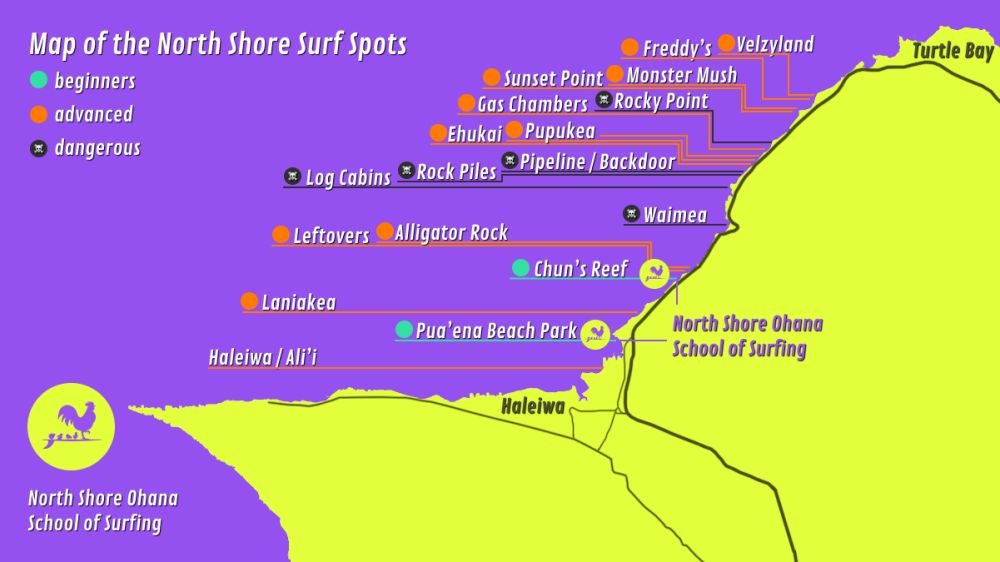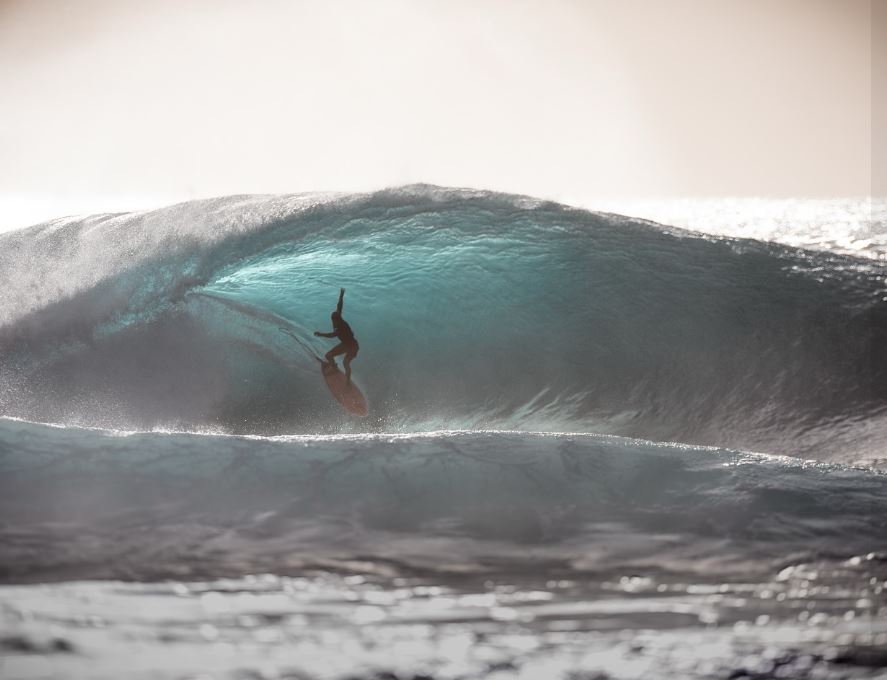Oʻahu is one of the best-known surfing spots in the world. Many visitors are first exposed to the beaches around Waikīkī, where the concentration of hotels and other amenities put fun in the ocean within easy reach. Hopefully, those surf adventure seekers will continue up the coastline to the less-concentrated North Shore. There are amazing—even legendary—beaches on that end of the island. Waves range from small and gently rolling to several stories high, depending on the time of year.
Though Oʻahu is a relatively small island (about half the size of the mainland’s Rhode Island) it boasts 227 miles of coastline, and not one bit of it is underwhelming. There are places all the way around the island where one can pull off and enjoy the view. Some are quiet bays while others are windows to the wild open sea. Knowing which areas are best suited for quiet strolls and which are the scenes of high adventure takes some investigation. This article will examine some of the more prominent ones, and what visitors should know to get the most out of their visits and to be safe throughout their time here. Please refer to the map, courtesy of North Shore ʻOhana School of Surfing (NSOSS), as we work our way up the coast and break down the levels of difficulty at each beach.

Map courtesy of North Shore ʻOhana School of Surfing. Red cross symbol indicates lifeguard on duty every day, 8 AM to 6:30 PM.
Beginner
Haleʻiwa
Just over 30 miles up the coast from Waikiki lies the historic surfing mecca of Haleʻiwa. This little town began as a sugar cane plantation village in the early 1800s, grew into a town in the early 1900s, and protects its historic vibe while simultaneously supporting the surfing culture that has thrived on the North Shore since the 1950s. Once a retreat for the aliʻi (royalty), Haleiwa’s beach seems to have it all: relatively quiet areas for swimming and canoeing, and usually fairly gentle waves, ideal for beginning surfers. Things can get more powerful between November and February, the prime high-surf months on the North Shore. This place is also known as the gateway to some of the most intense surf spots on the planet a little further up the coast. Lifeguards are on duty 8 AM to 6:30 PM.
Puaʻena Point
Puaʻena Point is known for its beautiful views of Kaʻena Point and Haleʻiwa Harbor at sunset, among other things. There’s a lot more sand than rock or coral under the water here, making is great for swimmers and beginning-level surfers. During high wave months, those ready to move up to intermediate level can practice here with relative ease. No lifeguards mentioned.
Chun’s Reef
The next spot north on our excursion is Chun’s Reef. NSOSS rates it a good choice for beginners and those progressing in skill level because of the depth of the water (less likelihood of hitting the reef below) and fairly gentle waves. They note that “[the] inside section can be good for beginners to catch the shoulder or whitewater” with its usual long, rolling waves. Chun’s Reef has lifeguards on duty 8 AM to 6:30 PM.
Turtle Bay West
Let’s skip past the highest intensity surf spots for a minute and roll on around to the north point of the island, at Turtle Bay. This seems to be where bold adventure starts to taper off into more mellow seas, so we don’t want to bury this spot at the end of the article—let’s keep it with the beginner-friendly spots. Turtle Bay is at the far north end of the island, providing plenty of shoreline for all kinds of water-related activities. Turtle Bay Resort is the linchpin here. The beach is public (as are all Oʻahu beaches), but the resort has added amenities for their guests, some of which are available to the public as well—showers, for one. They also have some other resort activities non-guests can pay to enjoy. No lifeguards mentioned.
Intermediate/Advanced:
Leftovers
Back down the coast, just north of Chun’s Reef, is Leftovers. There are sometimes beginner swells here, but most of the area is more attuned for higher-level surfers. Watch out for the jagged edges of the reef here—it’s nearer the surface. That could explain why this beach is rarely crowded. But those who know what to expect can get past the drama of entry and enjoy some nice rides. NSOSS points out a “walled up, racey, hollow section on the shallow inside bowl.” No lifeguards. Added bonus: there is usually plenty of parking.
Pupukea/ Ehukai
Again skipping over the most extreme locations, the Pupukea/Ehukai area is rated for local, experienced surfers. You have to know these waters to navigate them safely. This area is known as the entrance to “experts only” surf areas, so it can be expected to share some of their dangers as well as their highlights. Only those with lots of board hours and ocean savvy should surf here. No lifeguards.
Sunset Beach
Sunset Beach encompasses several surfing areas rated for advanced surfers, some of which are Gas Chambers, Sunset Point, Monster Mush, Freddy’s, and Velzyland. According to https://surfline.com, a major source of information and current surf conditions, rides in this area can range from nice little swells to monster waves. The unpredictability of water from the north can be particularly challenging, as can waves coming in at angles. Paddling out can mean long rides, and the ride back can also be tiring. Stamina is as important as experience here. Lifeguards at Sunset Beach proper, 8 AM to 6:30 PM. Lots of spectators at this location, so parking is tight.
Waimea
Waimea Bay houses a lovely tourist beach, though precautions should be taken, which is why this spot is listed in the Advanced category instead of Expert Only. But on the ocean side, Waimea is something very different. This is the home of the Eddie Aikau Surfing Contest, which only takes place in years when the cycle of conditions hits a peak. In fact, the surf has gotten so high here that all access has been cancelled. In other words, this can be the sight of some intense waves. That “winter” season, from November to February, produces the most intense swells, but this is dangerous territory all year. The good news is that there are lifeguards here daily, 8 AM to 6:30 PM
Expert Only

Photo by Matthew Allen at Pupukea. Matthew Allen.com
Note the positions on the map that are marked with black skull and crossbones symbols, and take heed. You could say this is where heʻe nalu (surfing) gets real. Starting at Waimea and extending through Log Cabins, Rock Piles, Backdoor, Pipeline, and Rocky Point, you are entering territory that only professional-level surfers should attempt, and sometimes even they will not go in.
Waves are highest here in the winter surf season—November through February—when waves can frequently tower at 30 feet, and sometimes higher. Heavy wave action, powerful crashes, and exposed reefs combine to make these locations treacherous for even the most seasoned locals. Only those who know these spots intimately should venture out.
The Banzai Pipeline, for Example
Who hasn’t heard of The Pipeline? It’s a tricky place; a variety of conditions can manifest in one spot. Sometimes the bowl seems benign. Random checks of the Surfline.com surf reports in April and May forecast waves in the 1 – 3-foot range. But remember the terrain and the fact that conditions can change rapidly. The massive underlying reef platform can redirect water and concentrate the power of swells, creating huge waves where none had existed moments before. And they roll in in sets. In winter, some forecasts tell surfers to expect waves four times the height of a tall adult. All the surf spots in this region have unseen, underwater structures that can propel water with incredible force, making it wonderous to watch, amazing to surf, and highly dangerous.
Surfers, Be Sensible
There are a few common-sense rules to follow if you want to leave Hawaiʻi with incredible surfing stories to tell:
- Know your skill level and act accordingly. The Pacific is no place for bravado.
- Research the surf spots you want to try and make sure they are right for you.
- Check reports of shark activity, and know what time of day jelly fish, rays, and other marine life might be vying with you for space in the water.
- Study conditions before you enter the water. If the weather is stormy or very windy, don’t go in.
- Always use quality equipment, and check it carefully for defects before every surf session.
- Have a spotter—someone who knows you are out there and is watching to see if you encounter any problems.
Spectators, Beware
Even those who have gathered to watch surfers have to take precautions. Every year there are instances in which people ignore signs, caution tape, and lifeguards to “get a better view” of the experts doing their thing. Lots of gear ends up in the water, as well as some pets and people that need to be rescued. Please understand that all those warnings are real. When the waves are running high, they can easily hit the beaches all the way back to the land walls, and with great force.
Actual footage of dangers at the Eddie, December 2024. (link this) https://www.hawaiinewsnow.com/2024/12/20/with-the-eddie-possible-groups-organizers-urge-safety-leave-lot-home/
Surfing can be one of the most exhilarating sports on the planet, both for the athletes and the observers; but it demands respect. Make your interaction with the ocean unforgettable for all the right reasons.


Recent Comments